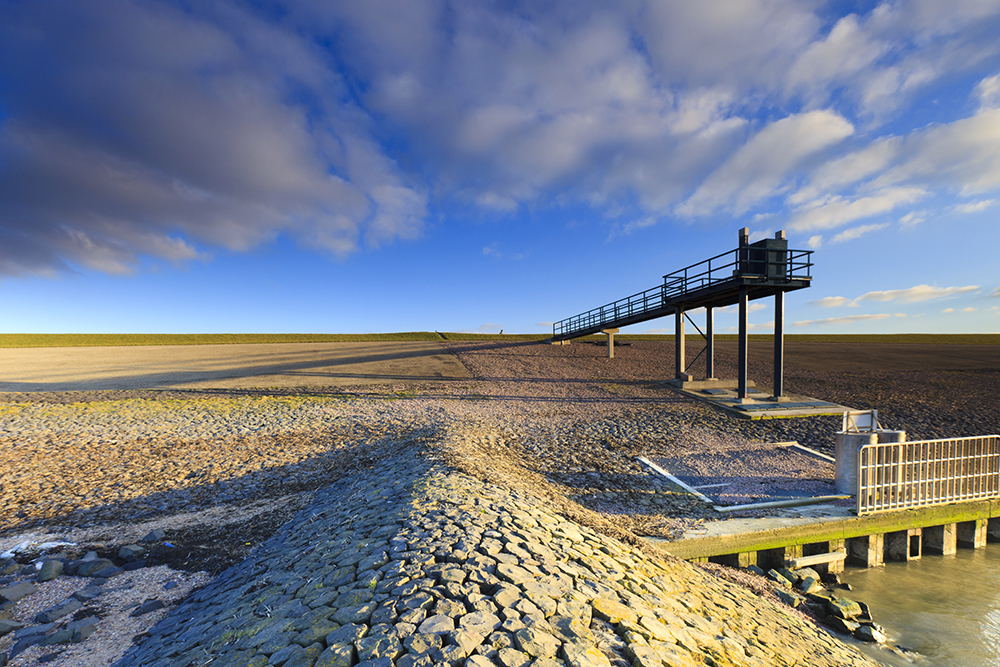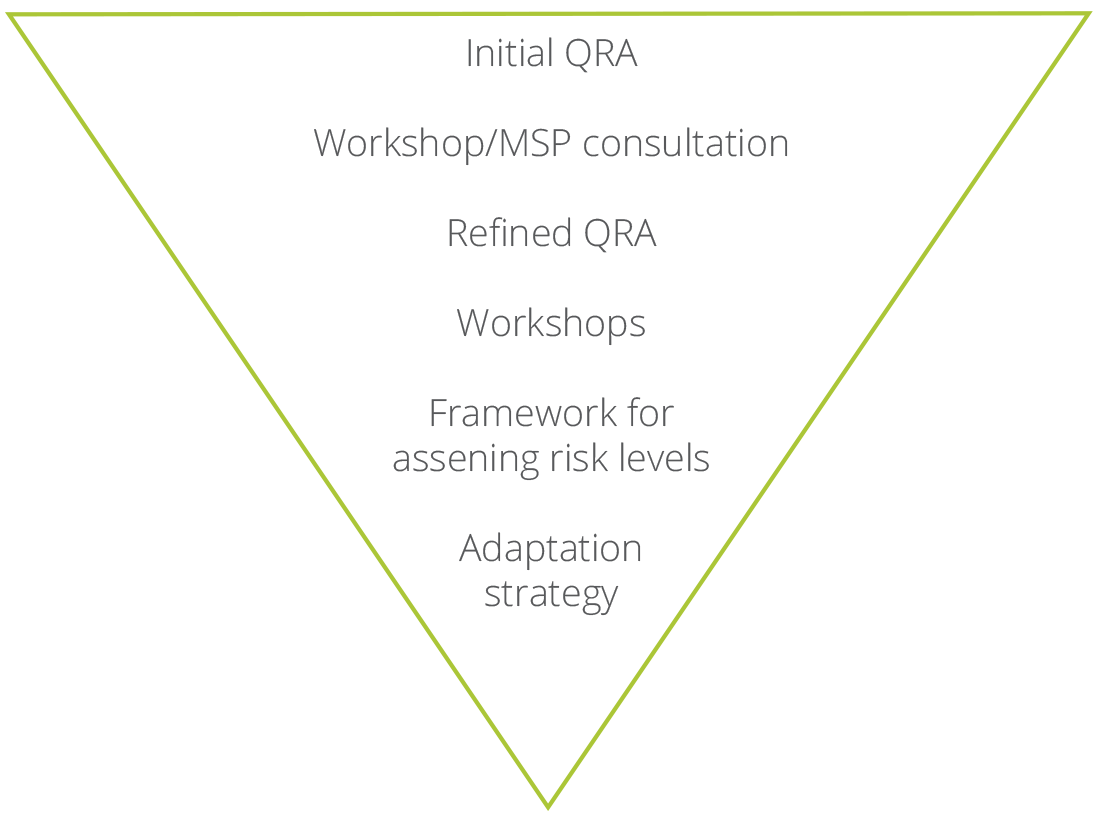Flood risk management Port of Rotterdam
Overall, floods caused more than €52 billion in insured economic losses, making floods the most costly hazard faced by Europe.
The Port of Rotterdam is located in the mouth of the Rhine-Meuse Delta in the Netherlands (see Figure 10.1). The port’s annual throughput amounts to some 450 million tonnes, which makes the Port of Rotterdam the largest port in Europe. Moreover, the port is one of the largest industrial and electricity hubs of Europe. Cargo finds its way to roughly 500 million consumers in Europe over water and over land. It is transported by trucks, trains, pipelines, inland vessels or sea-going vessels. Yearly, approximately 30,000 seagoing vessels and 110,000 inland vessels arrive in the Port of Rotterdam. The industrial cluster contains, amongst others, five oil refineries. The power plants in the port power a quarter of the industry and homes in the Netherlands. The total added value (direct and indirect) of the port is €22 billion, which is about 4% of the Dutch Gross National Income. Moreover, the strategic value of the port, as a logistic hub to the international business competitiveness of the Netherlands, is even 30% higher.
According to the Dutch national climate scenarios, it is expected that both the intensity and severity of natural hazards such as floods will increase. Severe economic damage can occur from long-term closures of the port and its industry (such events are considered low-probability, high-impact events). Moreover, economic developments and changes in the nature and size of businesses and industrial activities also affect the port’s exposure to floods. This raises the question how the port remains safe with respect to flooding in the future.
The case study ‘Port of Rotterdam’ focuses on the strategic preparation to prevent or minimise economic losses and societal disruption resulting from floods. The ultimate goal is to reduce and/or mitigate flood risk by strengthening or enhancing the current flood risk partnership (Multi-Sector Partnership, MSP) involving the Municipality of Rotterdam and the Province of South-Holland.
The initial evaluation of the MSP shows that private sector companies are not fully aware of the flood risk in the Port of Rotterdam. In order to increase the flood awareness, the flood risk has been mapped in a quantitative manner, and has been communicated in workshops with stakeholders.

Figure 10.1.
The Port of Rotterdam case study area.
Flood risk governance in the Port of Rotterdam
Most of the industrial areas within the Port of Rotterdam are unembanked (see Figure 10.1) and, due to its location near the North Sea, the port is potentially prone to storm surges and coastal flooding. To date, however, flood events have not caused any significant damage to the port. Most industrial areas are located on relatively high grounds and the port is considered safe against coastal floods. For most industrial areas, the flood probability is thought to be smaller than 1/1,000 per year, which is lower than the probability of flooding in most other large ports in the world.
The unembanked port areas are not incorporated in the national flood protection policy. Land owners and businesses located in these areas are responsible for their own flood protection. This underpins the importance of a good understanding of the flood risk they face.
The national government has delegated the ‘flood risk governance’ of unembanked areas to regional authorities. The Province of South-Holland and the Municipality of Rotterdam form the current Multi-Sector Partnership or Multi-Stakeholder Partnership. This MSP primarily aims to reduce the flood risk of new development projects on unembanked industrial areas in the Port of Rot-terdam. Since 2011, a new policy framework for building in unembanked areas is enforced by the Province. The City of Rotterdam applies a Risk Assessment Tool in order to evaluate and assess different design alternatives within new landuse and zoning plans. Note that this Risk Assessment Tool has not been developed to assess the flood risk of existing developments. In other words, the policy does not apply to most port areas as the development in these areas date from before 2011. Moreover, the Risk Assessment Tool only takes into account two indicators (casualties and societal disruption), while the direct and indirect economic losses due to a storm surge flood can have a sizeable impact on the Gross National Product. Hence, the question is to what extent the current partnership reduces (economic) flood risk.
Although other parties, such as the ministry of infrastructure, the water boards and the private sector (businesses and industry), were involved in the development of the provincial policy and the risk assessment tool, none of these other stakeholders have any formal liability or responsibility concerning flood protection. Furthermore, they are not involved in the decision-making process.
Health of the current MSP
Our assessment shows that there is a lack of awareness, information and communication between stakeholders in the port region with regard to flood risk of unembanked areas. Therefore, improving the available flood risk information, and improving insights in the consequences of a flood can, together with a sound communication strategy, make businesses more aware of flood risks in the Port of Rotterdam.

Implications of quantitative risk assessment for flood risk management
What are the conclusions and implications of the QRA for the current MSP?
- Climate change adversely affects the port’s flood risk. The consequences of potential floods are large in terms of economic losses and societal disruption. The Rotterdam port area is vital for the Dutch economy and society, and further discussion is needed to determine who should regulate the port’s flood protection: the national or regional government, the industry, the Port Authority or all together?
- The speed of recovery of the economy is an important issue as well. How should the (national) government and the industry deal with the knowledge that the recovery may take months?
- Without adequate risk information, businesses in the Port cannot take adequate risk reduction measures.
- The case study application shows added value of an enhanced risk assessment, which also covers superregional effects in the case of critical infrastructure systems and highly interconnected industrial networks.
Extending the current MSP
The enhanced MSP should at least include:
- the national government as the Port is of strategic importance to the country;
- the Port Authority as main ‘landlord’ of the Port area;
- the Municipality of Rotterdam;
- business and industry in the Port area as driving force of the Dutch economy;
- the Province of South-Holland;
- other stakeholders with knowledge required to reduce or mitigate flood risk or responsibilities with regards to a safe environment: e.g. environmental agency DCMR, safety region, water boards, and utility companies.
Pilot study: Botlek area
On the basis of the recommendations of the national Delta program on flood risk in unembanked areas, the national government started a ‘pilot study Botlek’ in 2015. This pilot study aims to develop a climate adaptation strategy for the Botlek area.
The pilot study started with a broad scope, the initial QRA, and converges to an adaptation strategy including the question of risk governance and responsibility (see Figure 10.6).

Figure 10.6.
Process to involve stakeholders in the Port of Rotterdam to de-velop a flood risk adaptation strategy.
The workshops in the pilot study Botlek have contributed to a higher flood awareness amongst the stakeholders and a better understanding of (future) flood risk in the area. The expected increase in flood risk and the vital importance of the Port of Rotterdam to The Netherlands ask for a joint response of the stakeholders: a climate adaptation strategy. This strategy will be the basis for further discussions on risk governance, responsibilities and risk financing.

Useful links
- Interactive overview of water risks in the world (Word Resources institute)
- Flood Resilience Portal





